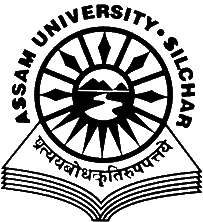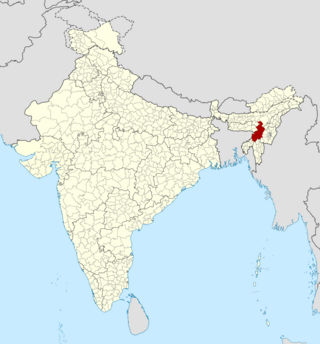
Cachardistrict is an administrative district in the state of Assam in India. After independence, the pre-existing undivided Cachar district was split into four districts: Dima Hasao, Hailakandi, Karimganj, and the current Cachar district. Silchar is Cachar district's center of government.

Hailakandi district is one of the 33 districts of Assam state in north-eastern India. It makes up the Barak Valley alongside Cachar and Karimganj. It was constituted as a civil subdivision on 1 June 1869. Subsequently, it was upgraded to a district in 1989, when it was split from Cachar district.

Karimganj district is one of the 34 districts of the Indian state of Assam. Karimganj town is both the administrative headquarters district and the biggest town of this district. It is located in southern Assam and borders Tripura and the Sylhet Division of Bangladesh. It makes up the Barak Valley alongside Hailakandi and Cachar. Karimganj was previously part of the Sylhet District before the Partition of India. It became a district in 1983.

Karimganj is a city in the Karimganj District of the Indian state of Assam. It is the administrative headquarters of the district.

Karimganj Lok Sabha constituency is one of the 14 Lok Sabha constituencies in Assam state in north-eastern India, covering Karimganj and Hailakandi districts in the Barak Valley. This constituency is reserved for the candidates belonging to the scheduled castes.
Lalit Mohan Suklabaidya is an Indian politician who was a Member of Parliament from Lok Sabha. He represented the Karimganj constituency in Assam from 2004 to 2014 and is a member of the Indian National Congress.
The Twipra Kingdom was one of the largest ancient - historical kingdoms of the Tripuri people in Northeast India.

The Barak Valley is the southernmost region and administrative division of the Indian state of Assam. It is named after the Barak river. The Barak valley consists of three administrative districts of Assam namely - Cachar, Karimganj, and Hailakandi. The main and largest city is Silchar, which seats the headquarter of Cachar district and also serves as administrative divisional office of Barak valley division. The valley is bordered by Mizoram and Tripura to the south, Bangladesh and Meghalaya to the west and Manipur to the east respectively. Once North Cachar Hills was a part of Cachar district which became a subdivision in 1951 and eventually a separate district. On 1 July 1983, Karimganj district was curved out from the eponymous subdivision of Cachar district. In 1989 the subdivision of Hailakandi was upgraded into Hailakandi district.

Assam University is a collegiate central public university located at Silchar, Assam, India. It was founded in the year 1994 by the provisions of an act enacted by the Parliament of India. Air Chief Marshal Arup Raha is the Chancellor, the Governor of Assam is the Chief Rector and the President of India is acting as the Visitor of the university. The university has sixteen schools which offer Humanities, Languages, Environmental Sciences, Information Sciences, Life Sciences, Physical Sciences, Social Sciences, Law, Technology and Management Studies. There are 42 departments under these sixteen schools. The five districts under the jurisdiction of Assam University have 73 undergraduate colleges as of 31 March 2020. Assam University is an institutional signatory to the Global Universities Network for Innovation (GUNI), Barcelona and United Nations Global Compact (UNGC) for its commitment to educational social responsibilities.

Sylhet region, is a geographical, historical, and cultural region located in the eastern part of the Indian subcontinent and consists of the Sylhet Division of Bangladesh, which includes the Surma Valley and three districts of the Barak Valley in the Indian state of Assam. In 1947, a referendum was held in Sylhet. According to the results of the referendum, Sylhet District, Sunamganj District, Habiganj District, and Karimganj district decided to join the Pakistani province of East Bengal, and South Sylhet decided to join India. When the Radcliffe Line was drawn, Karimganj was given to India by the commission, calling on a delegation led by Abdul Matlib Majumder; South Sylhet (Moulvibazar) was given to East Pakistan. Nihar Ranjan Roy, author of the book History of Bengalis, said that South Assam/North-East Bengal or the Barak Valley is extended from the larger Surma/Meghna Valley of Bengal in every aspect, from culture to geography.
Abdul Matlib Mazumder was an Indian freedom fighter and political leader based in undivided Assam State. In 1946, when India was still under British rule, he became an MLA and also Cabinet Minister of Assam. He was one of the prominent Muslim leaders of eastern India to support Hindu-Muslim unity, opposing the partition of India on communal lines. Mazumder along with Fakhruddin Ali Ahmed became the most prominent Muslim opponents of the demand for a separate Muslim state of Pakistan, especially in the eastern part of the country.

The Bengali Language Movement of Barak Valley was a protest against the decision of the Government of Assam to make Assamese the only sole official language of the state, even though most Barak Valley residents speak Bengali. About 80% of the Valley's residents are ethnic Bengalis. In the Barak Valley region, the ethnic Bengali population consists of both Hindus and Muslims, who are almost equal in population and constitute the overwhelming majority of the population. There is also a substantial minority of native tribals and immigrants from other parts of India. The main incident took place on 19 May 1961 at Silchar railway station in which 11 ethnic Bengalis were killed by the Assam police.
The Regions of Assam are non-administrative units in the Indian state of Assam with a common historical past. Not all these regions are mutually exclusive.

The Undivided Cachar district is a former administrative district of Assam Province that is largely congruous to Govinda Chandra's, the last king of the Kachari kingdom, domain in the southern part of Assam. It has been divided into the present-day Cachar, Dima Hasao and Hailakandi districts in recent times. Dima Hasao is an Autonomous hill district of Assam, remaining Cachar and Hailakhandi of Dimasa Kingdom are a part of Barak Valley region. While Karimganj was a part of Sylhet, before Partition of Bengal.
Assam – 16th largest, 15th most populous and 26th most literate state of the 28 states of the democratic Republic of India. Assam is at 14th position in life expectancy and 8th in female-to-male sex ratio. Assam is the 21st most media exposed states in India. The Economy of Assam is largely agriculture based with 69% of the population engaged in it. Growth rate of Assam's income has not kept pace with that of India's during the Post-British Era; differences increased rapidly since the 1970s. While the Indian economy grew at 6 percent per annum over the period of 1981 to 2000, the same of Assam's grew only by 3.3 percent.
Algapur Assembly constituency is one of the 126 Assembly constituencies in Hailakandi district in the North-East Indian state of Assam.
Badarpur Assembly constituency is one of the 126 constituencies of the Legislative Assembly of Assam state in northeastern India.

Bengali Hindus are the second-largest Hindu community just after Assamese Hindus in Assam. As per as estimation research, around 6–7.5 million Bengali Hindus live in Assam as of 2011, majority of whom live in Barak Valley and a significant population also resides in Assam's mainland Brahmaputra/Assam valley. Most Bengalis in Assamese-dominated Brahmaputra valley are immigrants from neighbouring East Bengal and Tripura, while Bengalis in Barak Valley region of Assam are mostly native. Assam host the second-largest Bengali Hindu population in India after West Bengal.

The Barak state movement includes political activities organised by various individuals, organizations and political parties, for creation of a separate state of Barak, within the republic of India, with Silchar as the capital. The proposed state corresponds to the 5 southern districts of the state of Assam namely: Cachar, Hailakandi, Karimganj, Dima Hasao, Hojai's and Jiribam of Manipur respectively. The total area and population of proposed state is 13,379 km² and 4.5 million as per 2011 Census. The area is covered by thick tropical forests and is surplus in natural resources like tea, oil, natural gas and jute. There are around 125 tea gardens across the Valley. The Minister of Petroleum and Natural Gas of India Mr. Hardeep Singh Puri on a visit have stated that the region is rich in natural gas and have further said that, "If those huge reserve is properly utilized, then it will definitely boost local industry & employment.
"All Cachar Karimganj Hailakandi Students Association", (ACKHSA) was established on 1983 by Mr. Pradip Dutta Roy, who has always placed utmost importance on advancement of the society. He belongs to the demographic whose fierce ideas bring about revolutionary change- in his case, the establishment of Assam University, after 10 years of movement under his leadership. The year 1983 marks the beginning of Dutta Roy's journey when he started the mass movement towards the educational development of Barak Valley. It was one fine evening, way back in the year 1983, on the 15th day of May, when Mr. Dutta Roy along with the respected Vice President and General Secretary of Students Union of all the colleges of Barak Valley had a round table discussion on the urgent need of establishing a Central University in the district of the then Undivided Cachar. Their objective behind the meeting witnessed its foundation in the formation of ACKHSA under the potent leadership of Mr. Pradip Dutta Roy. The main motive behind the idea of a Central University in Barak Valley was to open the door of higher education for the students in their Home Valley considering the torture and harassment that the students had to face when they went for pursuing their higher education in the mainland Assam Valley. This pathetic experience of the students touched the sentiment of Mr. Dutta Roy who then decided that a Central University was the need of the hour. After 10 long years of the struggle, Barak Valley finally saw the light of Assam University in the year 1994. He was honored with a doctorate degree from the World Development Parliament in the year 1994, but he dedicated it in the name of the eleven martyrs, who sacrificed their lives for upholding Bengali language on 19th May, 1961.












